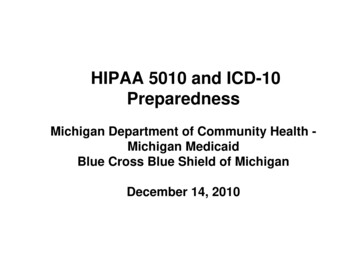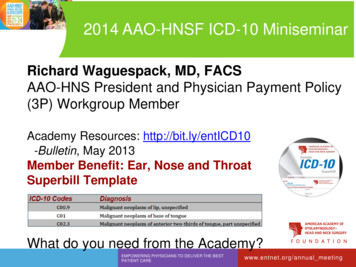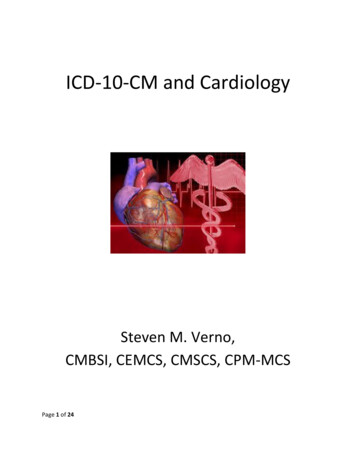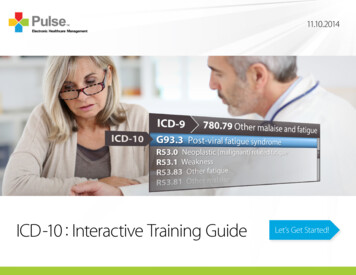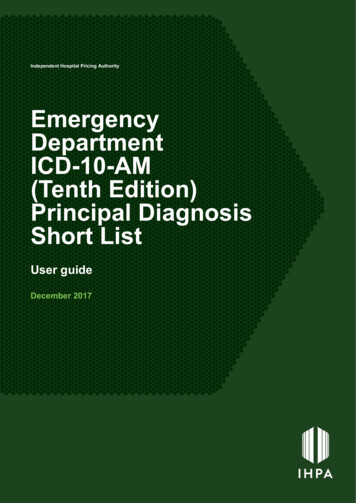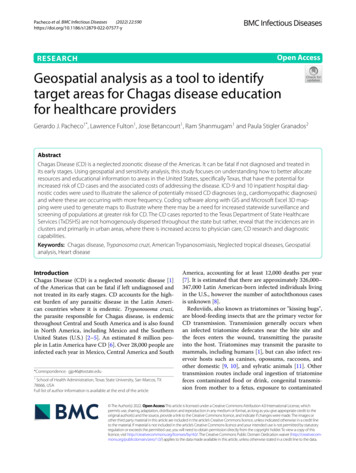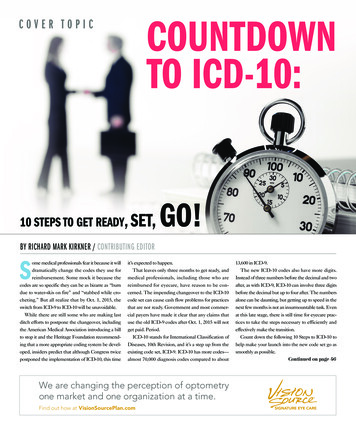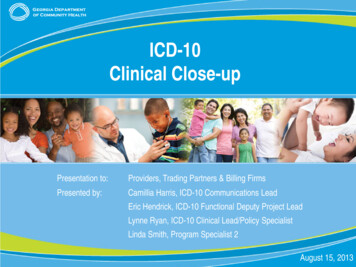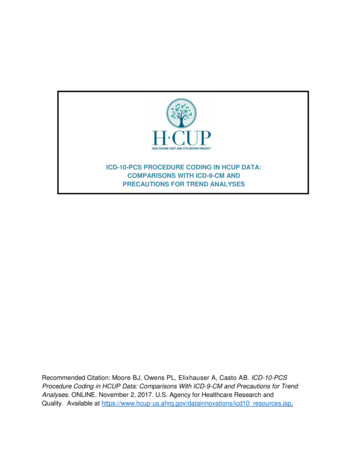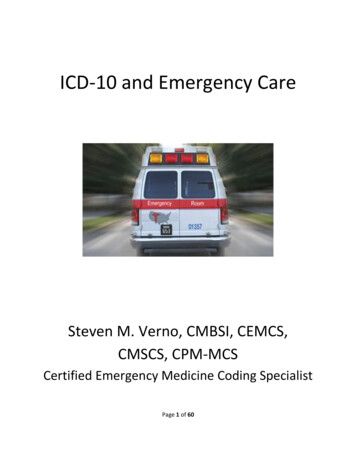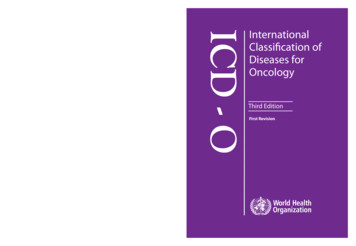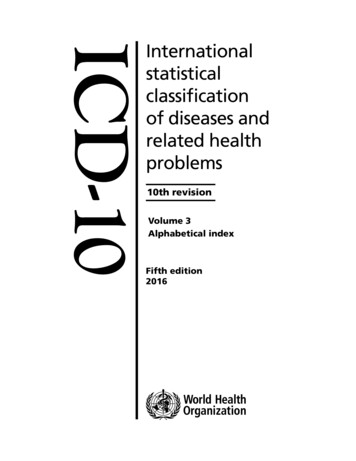
Transcription
ICD-10Internationalstatisticalclassificationof diseases andrelated healthproblems10th revisionVolume 3Alphabetical indexFifth edition2016
WHO Library Cataloguing-in-Publication DataInternational statistical classification of diseases and related health problems. - 10th revision, Fifth edition, 2016.3 v.Contents: v. 1. Tabular list -- v. 2. Instruction manual -- v. 3. Alphabetical index.1.Diseases - classification. 2.Classification. 3.Manuals. I.World Health Organization. II.ICD-10.ISBN 978 92 4 154916 5(NLM classification: WB 15) World Health Organization 2011.Reprinted in 2015.All rights reserved. Publications of the World Health Organization are available on the WHO website (www.who.int) or canbe purchased from WHO Press, World Health Organization, 20 Avenue Appia, 1211 Geneva 27, Switzerland (tel.: 41 22 7913264; fax: 41 22 791 4857; e-mail: bookorders@who.int).Requests for permission to reproduce or translate WHO publications – whether for sale or for non-commercial distribution –should be addressed to WHO Press through the WHO website (www.who.int/about/licensing/copyright form/en/index.html).The designations employed and the presentation of the material in this publication do not imply the expression ofany opinion whatsoever on the part of the World Health Organization concerning the legal status of any country,territory, city or area or of its authorities, or concerning the delimitation of its frontiers or boundaries. Dottedand dashed lines on maps represent approximate border lines for which there may not yet be full agreement.The mention of specific companies or of certain manufacturers’ products does not imply that they are endorsed orrecommended by the World Health Organization in preference to others of a similar nature that are not mentioned. Errorsand omissions excepted, the names of proprietary products are distinguished by initial capital letters.All reasonable precautions have been taken by the World Health Organization to verify the information contained in thispublication. However, the published material is being distributed without warranty of any kind, either expressed or implied.The responsibility for the interpretation and use of the material lies with the reader. In no event shall the World HealthOrganization be liable for damages arising from its use.Printed in France
ContentsIntroductionGeneral arrangement of the IndexConventions used in the IndexAlphabetical index to diseases and nature of injury1159External causes of injury663Table of drugs and chemicals717iii
IntroductionVolume 3 of the International Statistical Classification of Diseases andRelated Health Problems is an alphabetical index to the Tabular List ofVolume 1. Although the Index reflects the provisions of the Tabular List inregard to the notes varying the assignment of a diagnostic term when it isreported with other conditions, or under particular circumstances (e.g. certainconditions complicating pregnancy), it is not possible to express all suchvariations in the index terms. Volume 1 should therefore be regarded as theprimary coding tool. The Alphabetical Index is, however, an essential adjunctto the Tabular List, since it contains a great number of diagnostic terms thatdo not appear in Volume 1. The two volumes must therefore be usedtogether.The terms included in a category of the Tabular List are not exhaustive; theyserve as examples of the content of the category or as indicators of its extentand limits. The Index, on the other hand, is intended to include most of thediagnostic terms currently in use. Nevertheless, reference should always bemade back to the Tabular List and its notes, as well as to the guidelinesprovided in Volume 2, to ensure that the code given by the Index fits with theinformation provided by a particular record.Because of its exhaustive nature, the Index inevitably includes manyimprecise and undesirable terms. Since these terms are still occasionallyencountered on medical records, coders need an indication of theirassignment in the classification, even if this is to a rubric for residual or illdefined conditions. The presence of a term in this volume, therefore, shouldnot be taken as implying approval of its usage.General arrangement of the IndexMain sectionsThe Alphabetical Index consists of the three sections, as follows:Section I is the index of diseases, syndromes, pathological conditions,injuries, signs, symptoms, problems and other reasons for contact with healthservices, i.e. the type of information that would be recorded by a physician. Itincludes all terms classifiable to categories A00 T98 and Z00 Z99 exceptdrugs and other chemical substances giving rise to poisoning or other adverseeffects (these are included in Section III).1
IntroductionVolume 3 of the International Statistical Classification of Diseases andRelated Health Problems is an alphabetical index to the Tabular List ofVolume 1. Although the Index reflects the provisions of the Tabular List inregard to the notes varying the assignment of a diagnostic term when it isreported with other conditions, or under particular circumstances (e.g. certainconditions complicating pregnancy), it is not possible to express all suchvariations in the index terms. Volume 1 should therefore be regarded as theprimary coding tool. The Alphabetical Index is, however, an essential adjunctto the Tabular List, since it contains a great number of diagnostic terms thatdo not appear in Volume 1. The two volumes must therefore be usedtogether.The terms included in a category of the Tabular List are not exhaustive; theyserve as examples of the content of the category or as indicators of its extentand limits. The Index, on the other hand, is intended to include most of thediagnostic terms currently in use. Nevertheless, reference should always bemade back to the Tabular List and its notes, as well as to the guidelinesprovided in Volume 2, to ensure that the code given by the Index fits with theinformation provided by a particular record.Because of its exhaustive nature, the Index inevitably includes manyimprecise and undesirable terms. Since these terms are still occasionallyencountered on medical records, coders need an indication of theirassignment in the classification, even if this is to a rubric for residual or illdefined conditions. The presence of a term in this volume, therefore, shouldnot be taken as implying approval of its usage.General arrangement of the IndexMain sectionsThe Alphabetical Index consists of the three sections, as follows:Section I is the index of diseases, syndromes, pathological conditions,injuries, signs, symptoms, problems and other reasons for contact with healthservices, i.e. the type of information that would be recorded by a physician. Itincludes all terms classifiable to categories A00 T98 and Z00 Z99 exceptdrugs and other chemical substances giving rise to poisoning or other adverseeffects (these are included in Section III).1
INTERNATIONAL CLASSIFICATION OF DISEASESSection II is the index of external causes of injury. The terms included hereare not medical diagnoses but descriptions of the circumstances in which theviolence occurred (e.g. fire, explosion, fall, assault, collision, submersion). Itincludes all terms classifiable to V01 Y98, except drugs and chemicals.Section III is the index of drugs and other chemical substances giving rise topoisoning or other adverse effects (referred to in Sections I and II as theTable of drugs and chemicals). For each substance the Table gives theChapter XIX code for poisoning (T36 T65) and the external cause (ChapterXX) codes for accidental poisoning by and exposure to noxious substances(X40 X49), intentional self-harm (X60 X69), and poisoning, undeterminedwhether accidental or intentional (Y10 Y19). For drugs, medicaments andbiological substances, it also gives the code for these substances causingadverse effects in therapeutic use (Y40 Y59).StructureTo avoid unnecessary repetition, the Index is organized in the form of leadterms, which start at the extreme left of a column, and various levels ofindentation, which start progressively further right. A complete index term,therefore, may be composed of several lines, sometimes quite widelyseparated. For example, in the entry:Erythroblastosis (fetalis) (newborn) P55.9– due to– – ABO (antibodies) (incompatibility) (isoimmunization) P55.1– – Rh (antibodies) (incompatibility) (isoimmunization) P55.0the last line stands for "Erythroblastosis due to Rh antibodies, incompatibilityor isoimmunization".Usually, the lead term is the name of a disease or pathological condition,while the terms indented beneath it (the "modifiers") refer either to varietiesof the condition, to the anatomical sites affected by it, or to circumstancesthat affect its coding. The coder should therefore look up the disease orcondition as a lead term and then find the variety, anatomical site, etc.,indented beneath it. Thus "tuberculosis of hip" is under the letter T and notunder H, and stomach ulcer is under U, not under S. Only occasionally areanatomical sites indexed as the lead term. Usually, after the name of theanatomical site there will be a cross-reference to the disease, e.g. Ankle seecondition.[Footnote: The name of an anatomical site appears as a lead term when it is part ofthe name of the disease, e.g. "abdomen, acute R10.0". This does not occur frequentlyin English, and in the English-language version applies mainly to Latin expressionsfor some conditions, e.g. "Cor biloculare".]2
INTRODUCTIONIn some diagnostic statements, the disease condition is expressed inadjectival form. Sometimes, the index lists both forms but often only thenoun form will be found and the coder must make the necessarytransformation.Among the indented modifiers, it is always feasible to include a completelisting of the various combinations of modifiers that could apply to a giventerm. In such circumstances, some types of modifier tend to have priority inassignment over others. For instance, under the lead term "Abscess" areindented a large number of anatomical sites and their appropriate codes.However, tuberculous abscesses are not classified to these codes but to thecodes for tuberculosis of these sites. Instead of inserting an indent"tuberculous" under each anatomical site, the index uses one single indent"tuberculous see Tuberculosis, abscess" under the lead term "Abscess". Ingeneral, the types of modifiers that tend to have priority in Section I are thoseindicating that a disease or condition is infectious or parasitic, malignant,neoplastic, psychogenic, hysterical, congenital, traumatic, complicating oraffecting the management of pregnancy, childbirth or the puerperium, oraffecting the fetus or newborn, or that the disease was reported incircumstances where the patient was looking for health advice but was notnecessarily sick (cases in Chapter XXI). In Section II, the priority modifiersare those indicating transport accidents, complications of medical andsurgical procedures, intentional self-harm, assault, legal intervention, or waroperations.Section I incorporates an index of the categories to be used with Chapter XXI[Footnote: Formerly the supplementary "V" code.]for terms relating to problems or circumstances rather than diseases orinjuries. Some special lead terms, or "key" words, are used for these,indicating the type of problem or circumstances. The main key words are"Counseling", "Examination", "History", "Observation", "Pregnancy","Problem", "Screening", "Status", and "Vaccination".In both Sections I and II, this key word form of lead term is also used insteadof, or in addition to, the standard method for certain conditions orcircumstances where terminology is diverse and reported descriptions mightnot easily be found in the Index, or where the normal method of indexingmight be misleading. Some obstetric complications, especially the morecommon ones, can be found under the specific condition, e.g. Hemorrhage,complicating delivery. More often, however, the complication will be listedunder "Labor", "Pregnancy", "Puerperal", or "Maternal condition affectingfetus or newborn". In Section II, key words are "Complication" (for medicalor surgical procedures), "Sequelae", "Suicide", "Assault", "Legalintervention" and "War operations". Coders should remember the presence of3
INTERNATIONAL CLASSIFICATION OF DISEASESthe special lists whenever they have difficulty locating index entries for therelevant conditions, problems or circumstances; by scrutinizing the indentedterms, guidance can be found as to the code numbers of all the relevantcategories even if not reported in precisely the same words.Code numbersThe code numbers that follow the terms in the Index are those of the three- orfour-character categories to which the terms are classified. In some cases, thefourth character is replaced by a dash, e.g. Burn, ankle (and foot) T25. . Thisindicates that a fourth character exists and should be used, and that it will befound either in a note in the Index (e.g. the fourth-character subdivisionscommon to many sites of burns are given in a note under the lead term"Burn") or by reference to Volume 1.When a set of fourth characters is applicable to a group of categories, thecommon fourth characters may be presented in a note or, in the case ofpregnancies with abortive outcome, in a table in order to facilitate theirapplication to different types of complete or incomplete abortion and tomolar pregnancies. In other cases, the complication or main manifestation islisted in the Index with a cross-reference to the entire group of categories,with specification of the fourth character, e.g. Coma, diabetic code toE10 E14 with fourth character .0.Where an index term is one of the diagnostic statements for which there is adual classification according to etiology and manifestation (see Volume 2),both codes are given, the first followed by a dagger (†) and the second by anasterisk (*), e.g. Pott's disease A18.0† M49.0*.Multiple diagnosesThe Tabular List includes a number of categories for the classification of twoor more conditions jointly reported, e.g. "Influenza with pneumonia" (J11.0),"Acute appendicitis with generalized peritonitis" (K35.2). Such combinationsof conditions, which are specifically classified in the Tabular List, alsoappear in the Index. Classification rules for certain other combinations appearin Volume 2 in the section "Mortality: guidelines for certification and rulesfor coding" under the heading "Notes for use in underlying cause mortalitycoding", e.g. "Atherosclerosis" should not be coded when it is reported withconditions in I60 I69 (cerebrovascular diseases). These provisions, sincethey are not inherent in the classification itself, are not indexed.4
INTRODUCTIONSpellingIn order to avoid repetitions caused by the differences between American andBritish spelling, the American form has been used in the Index. Usersfamiliar with the British form should remember that the first letter of thevowel combinations ae and oe and the u in words ending in -our have beendropped, and the "re" reversed to "er" in words ending thus. It is only whenthe initial letters are affected that any great displacement in alphabetical orderis caused, and in this case, the word is usually also listed with the Britishspelling and a reference given to the American spelling, thus: "Oedema,oedematous see Edema".Conventions used in the IndexParenthesesIn the Index, as in the Tabular List, parentheses have a special meaningwhich the coder must bear in mind. A term that is followed by other terms inparentheses is classified to the given code number whether any of the termsin parentheses are reported or not. For example:Abscess (embolic) (infective) (metastatic) (multiple) (pyogenic)(septic)– brain (any part) G06.0Brain abscess is classified to G06.0 regardless of the part of the organaffected and whether or not the abscess is described as embolic, infective,metastatic, multiple, pyogenic, or septic.Cross-referencesSome categories, particularly those subject to notes linking them with othercategories, require rather complex indexing arrangements. To avoid repeatingthis arrangement for each of the inclusion terms involved, a cross-reference isused. This may take a number of forms, as in the following examples:Inflammation– bone see OsteomyelitisThis indicates that the term "Inflammation, bone" is to be coded in the sameway as the term "Osteomyelitis". On looking up the latter term, the coder willfind listed various forms of osteomyelitis: acute, acute hematogenous,chronic, etc.5
INTERNATIONAL CLASSIFICATION OF DISEASESWhen a term has a number of modifiers which might be listed beneath morethan one term, the cross-reference (see also.) is used.Paralysis– shaking (see also Parkinsonism) G20The coder is told that if the term "shaking paralysis" is the only term on themedical record, the code number is G20, but that if any other information ispresent which is not found indented below, he or she should look up"Parkinsonism". There alternative codes will be found for the condition iffurther or otherwise qualified as, for example, due to drugs or syphilitic.Enlargement, enlarged see also HypertrophyIf the coder does not find the site of the enlargement among the indentationsbeneath "Enlargement", he or she should look among the indentationsbeneath "Hypertrophy" where a more complete list of sites is given.Bladder see conditionHereditary see conditionAs stated previously, anatomical sites and very general adjectival modifiersare not usually used as lead terms in the Index and the coder is instructed tolook up the disease or injury reported on the medical record and under thatterm to find the site or adjectival modifier.Abdomen, abdominal see also condition– acute R10.0– convulsive equivalent G40.8– muscle deficiency syndrome Q79.4The term "acute abdomen" is coded to R10.0; "abdominal convulsiveequivalent" is coded to G40.8; and "abdominal muscle deficiency syndrome"is coded to Q79.4. For other abdominal conditions, the coder should look upthe disease or injury reported.Abbreviation NECThe letters NEC stand for "not elsewhere classified". They are added afterterms classified to residual or unspecific categories and to terms inthemselves ill defined as a warning that specified forms of the conditions areclassified differently. If the medical record includes more precise informationthe coding should be modified accordingly, e.g.Anomaly, anomalous (congenital) (unspecified type) Q89.9– aorta (arch) NEC Q25.96
INTRODUCTIONThe term "anomaly of aorta" is classified to Q25.4 only if no more precisedescription appears on the medical record. If a more precise term, e.g. atresiaof aorta, is recorded, this term should be looked up for the appropriate code.Special signsThe following special signs will be found attached to certain code numbers orindex terms:† / * Used to designate the etiology code and the manifestation coderespectively, for terms subject to dual classification. See above under "Codenumbers".# / Attached to certain terms in the list of sites under "Neoplasm" to referthe coder to Notes 2 and 3, respectively, at the start of that list.7
Section IAlphabetical index to diseases andnature of injury
ALPHABETICAL INDEX TO DISEASES AND NATURE OF INJURYAAarskog's syndrome Q87.1Abandonment T74.0Abasia(-astasia) (hysterical) F44.4Abdomen, abdominal – see also condition– acute R10.0– convulsive equivalent G40.8– muscle deficiency syndrome Q79.4Abdominalgia R10.4Abduction contracture, hip or otherjoint – see Contraction, jointAberrant (congenital) – see alsoMalposition, congenital– adrenal gland Q89.1– artery (peripheral) NEC Q27.8– breast Q83.8– endocrine gland NEC Q89.2– hepatic duct Q44.5– pancreas Q45.3– parathyroid gland Q89.2– pituitary gland Q89.2– sebaceous glands, mucous membrane,mouth, congenital Q38.6– spleen Q89.0– subclavian artery Q27.8– thymus (gland) Q89.2– thyroid gland Q89.2– vein (peripheral) NEC Q27.8Aberration, mental F99Abetalipoproteinemia E78.6Abiotrophy R68.8Ablatio, ablation– placentae (see also Abruptio placentae)O45.9– – affecting fetus or newborn P02.1– retinae (see also Detachment, retina)H33.2– uterus Z90.7Ablepharia, ablepharon Q10.3Abnormal, abnormality, abnormalities –see also Anomaly– acid-base balance (mixed) E87.4– – fetus – see Distress, fetal– albumin R77.0– alphafetoprotein R77.2– amnion, amniotic fluid O41.9– – affecting fetus or newborn P02.9– apertures, congenital, diaphragm Q79.1– auditory perception NEC H93.2– autosomes NEC Q99.9Abnormal, abnormality––continued– autosomes NEC––continued– – fragile site Q95.5– basal metabolic rate R94.8– biosynthesis, testicular androgen E29.1– blood level (of)– – cobalt R79.0– – copper R79.0– – iron R79.0– – lithium R78.8– – magnesium R79.0– – mineral NEC R79.0– – zinc R79.0– blood-gas level R79.8– bowel sounds R19.1– breathing NEC R06.8– caloric test R94.1– cervix NEC (acquired) (congenital), inpregnancy or childbirth O34.4– – causing obstructed labor O65.5– – – affecting fetus or newborn P03.1– chemistry, blood R79.9– – specified NEC R79.8– chest sounds (friction) (rales) R09.8– chorion O41.9– – affecting fetus or newborn P02.9– chromosome, chromosomal Q99.9– – analysis result R89.8– – dicentric replacement Q93.2– – female with more than three Xchromosomes Q97.1– – fetal (suspected), affecting managementof pregnancy O35.1– – ring replacement Q93.2– – sex Q99.8– – – female phenotype Q97.9– – – – specified NEC Q97.8– – – male phenotype Q98.9– – – – specified NEC Q98.8– – – structural, male Q98.6– – specified NEC Q99.8– clinical findings NEC R68.8– coagulation D68.9– – newborn, transient P61.6– communication – see Fistula– course, eustachian tube Q16.4– diagnostic imaging– – abdomen, abdominal region NECR93.511
INTERNATIONAL CLASSIFICATION OF DISEASESAbnormal, abnormality––continued– diagnostic imaging––continued– – biliary tract R93.2– – breast R92– – central nervous system NEC R90.8– – coronary circulation R93.1– – digestive tract NEC R93.3– – gastrointestinal (tract) R93.3– – genitourinary organs R93.8– – head R93.0– – heart R93.1– – intrathoracic organs NEC R93.8– – limbs R93.6– – liver R93.2– – lung (field) R91– – musculoskeletal system NEC R93.7– – retroperitoneum R93.5– – sites specified NEC R93.8– – skin and subcutaneous tissue R93.8– – skull R93.0– – urinary organs R93.4– ear ossicles, acquired NEC H74.3– echocardiogram R93.1– echoencephalogram R90.8– echogram – see Abnormal, diagnosticimaging– electrocardiogram (ECG) (EKG) R94.3– electroencephalogram (EEG) R94.0– electrolyte (see also Imbalance,electrolyte) E87.8– electromyogram (EMG) R94.1– electro-oculogram (EOG) R94.1– electrophysiological intracardiac studiesR94.3– electroretinogram (ERG) R94.1– feces (color) (contents) (mucus) R19.5– fetus, fetal– – acid-base balance, complicating laborand delivery O68.3– – affecting management of pregnancyO35.9– – causing disproportion O33.7– – – with obstructed labor O66.3– – – affecting fetus or newborn P03.1– – heart rate – see Distress, fetal– finding– – antenatal screening, mother O28.9– – – biochemical NEC O28.1– – – chromosomal NEC O28.5– – – cytological NEC O28.2– – – genetic NEC O28.5– – – hematological NEC O28.0– – – radiological NEC O28.4– – – specified NEC O28.812Abnormal, abnormality––continued– finding––continued– – antenatal screening, mother––continued– – – ultrasonic O28.3– – specimen – see Abnormal, specimen– fluid– – amniotic R89.– – cerebrospinal R83.– – peritoneal R85.– – pleural R84.– – respiratory organs (bronchial washings)(nasal secretions) (pleural fluid)(sputum) (throat scrapings) R84.– – synovial R89.– – thorax (bronchial washings) (pleuralfluid) R84.– – vaginal R87.– forces of labor O62.9– – affecting fetus or newborn P03.6– – specified type NEC O62.8– form– – teeth K00.2– – uterus – see Anomaly, uterus– function studies– – bladder R94.8– – brain R94.0– – cardiovascular R94.3– – endocrine NEC R94.7– – kidney R94.4– – liver R94.5– – nervous system– – – central R94.0– – – peripheral R94.1– – pulmonary R94.2– – special senses R94.1– – spleen R94.8– – thyroid R94.6– gait (see also Gait) R26.8– – hysterical F44.4– globulin R77.1– – cortisol-binding E27.8– – thyroid-binding E07.8– glomerular, minor – code to N00-N07with fourth character .0– glucose tolerance (test) R73.0– – in pregnancy, childbirth or puerperiumO99.8– gravitational (G) forces or states (effectof) T75.8– hair (color) (shaft) L67.9– – specified NEC L67.8– hard tissue formation in pulp (dental)K04.3– head movement R25.0
ALPHABETICAL INDEX TO DISEASES AND NATURE OF INJURYAbnormal, abnormality––continued– heart– – rate NEC R00.8– – – fetus – see Distress, fetal– – shadow R93.1– – sounds NEC R01.2– hematological NEC, resulting from HIVdisease B23.2– hemoglobin (disease) (see also Disease,hemoglobin) D58.2– – trait – see Trait, hemoglobin, abnormal– histology NEC R89.7– immunological findings R89.4– – in serum R76.9– – – specified NEC R76.8– – resulting from HIV disease B23.2– involuntary movement R25.8– jaw closure K07.5– karyotype R89.8– kidney function test R94.4– labor NEC O75.8– – affecting fetus or newborn P03.6– leukocyte (cell) (differential) NEC R72– loss of weight R63.4– Mantoux test R76.1– membranes (fetal)– – affecting fetus or newborn P02.9– – complicating pregnancy O41.9– – specified type NEC, affecting fetus ornewborn P02.8– movement (disorder) (see also Disorder,movement) G25.9– – head R25.0– – involuntary R25.8– myoglobin (Aberdeen) (Annapolis) R89.– organs or tissues of pelvis NEC– – in pregnancy or childbirth O34.9– – – affecting fetus or newborn P03.8– – – causing obstructed labor O65.5– – – – affecting fetus or newborn P03.1– – – specified NEC O34.8– palmar creases Q82.8– Papanicolaou (smear)– – cervix R87.6– – sites NEC R89.6– parturition– – affecting fetus or newborn P03.9– – mother – see Delivery, complicated– pelvis (bony) – see Deformity, pelvis– percussion, chest (tympany) R09.8– periods (grossly) (see also Menstruation)N92.6– phonocardiogram R94.3Abnormal, abnormality––continued– placenta NEC (see also Placenta,abnormal) O43.1– plasma– – protein R77.9– – – specified NEC R77.8– – viscosity R70.1– pleural (folds) Q34.0– position – see Malposition– posture R29.3– presentation (fetus) (see also Presentation,fetal, abnormal) O32.9– – before labor, affecting fetus or newbornP01.7– product of conception O02.9– – specified type NEC O02.8– pulmonary– – artery, congenital Q25.7– – function, newborn P28.8– – test results R94.2– – ventilation, newborn P28.8– pupillary function (reaction) (reflex)H57.0– radiological examination – see Abnormal,diagnostic imaging– red blood cell(s) (morphology) (volume)R71– reflex NEC (see also Reflex) R29.2– renal function test R94.4– response to nerve stimulation R94.1– retinal correspondence H53.3– rhythm, heart (see also Arrhythmia) I49.9– – fetus – see Distress, fetal– saliva R85.– secretion– – gastrin E16.4– – glucagon E16.3– semen, seminal fluid R86.– serum level (of)– – acid phosphatase R74.8– – alkaline phosphatase R74.8– – amylase R74.8– – enzymes R74.9– – – specified NEC R74.8– – lipase R74.8– – triacylglycerol lipase R74.8– shape, gravid uterus – see Anomaly,uterus– sinus venosus Q21.1– size, tooth, teeth K00.2– spacing, tooth, teeth K07.3– specimen– – cervix uteri R87.-13
INTERNATIONAL CLASSIFICATION OF DISEASESAbnormal, abnormality––continued– specimen––continued– – digestive organs (peritoneal fluid)(saliva) R85.– – female genital organs (secretions)(smears) R87.– – male genital organs (prostaticsecretions) (semen) R86.– – nipple discharge R89.– – respiratory organs (bronchial washings)(nasal secretions) (pleural fluid)(sputum) (throat scrapings) R84.– – specified organ, system or tissue NECR89.– – synovial fluid R89.– – thorax (bronchial washings) (pleuralfluids) R84.– – vagina (secretion) (smear) R87.– – vulva (secretion) (smear) R87.– – wound secretion R89.– spermatozoa R86.– sputum (amount) (color) (odor) R09.3– stool (color) (contents) (mucus) R19.5– synchondrosis Q78.8– thermography – see Abnormal, diagnosticimaging– thyroid-binding globulin E07.8– tooth, teeth (form) (size) K00.2– toxicology (findings) R78.9– transport protein E88.0– ultrasound results – see Abnormal,diagnostic imaging– umbilical cord– – affecting fetus or newborn P02.6– – complicating delivery O69.9– urination NEC R39.1– urine (constituents) NEC R82.9– – cytological examination R82.8– – heavy metals R82.6– – histological examination R82.8– – microbiological examination (culture)R82.7– – positive culture R82.7– – specified NEC R82.9– – substances nonmedical R82.6– vagina (acquired) (congenital), inpregnancy or childbirth O34.6– – causing obstructed labor O65.5– – – affecting fetus or newborn P03.1– vectorcardiogram R94.3– visually evoked potential (VEP) R94.1– vulva and perineum (acquired)(congenital), in pregnancy or childbirthO34.714Abnormal, abnormality––continued– vulva and perineum––continued– – causing obstructed labor O65.5– – – affecting fetus or newborn P03.1– white blood cells NEC R72– X-ray examination – see Abnormal,diagnostic imagingAbnormity (any organ or part) – seeAnomalyABO hemolytic disease (fetus or newborn)P55.1Abolition, language R48.8Aborter, habitual or recurrent NEC– care in current pregnancy O26.2– current abortion – see categories O03-O06– – affecting fetus or newborn P01.8– without current pregnancy N96Abortion (complete) (incomplete) O06.– accidental O03.– attempted (failed) (induced) (nonmedical)O07.9– – complicated by– – – afibrinogenemia O07.6– – – cardiac arrest O07.8– – – chemical damage of pelvic organ(s)O07.8– – – circulatory collapse O07.8– – – defibrination syndrome O07.6– – – electrolyte imbalance O07.8– – – embolism (amniotic fluid) (bloodclot) (pulmonary) (septic) (soap)O07.7– – – endometritis O07.5– – – hemorrhage (delayed) (excessive)O07.6– – – infection, genital tract or pelvicO07.5– – – intravascular coagulatio
1 Introduction Volume 3 of the International Statistical Classification of Diseases and Related Health Problems is an alphabetical index to the Tabular List of Volume 1. Although the Index reflects the provisions of the Tabular List in regard to the notes varying the assignment of a diagnostic term when it is
